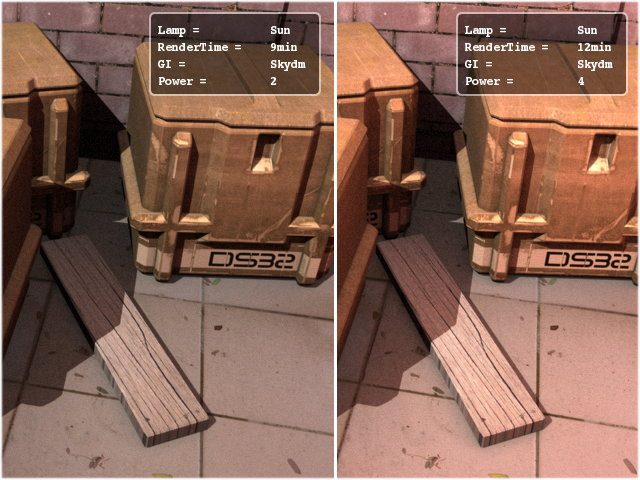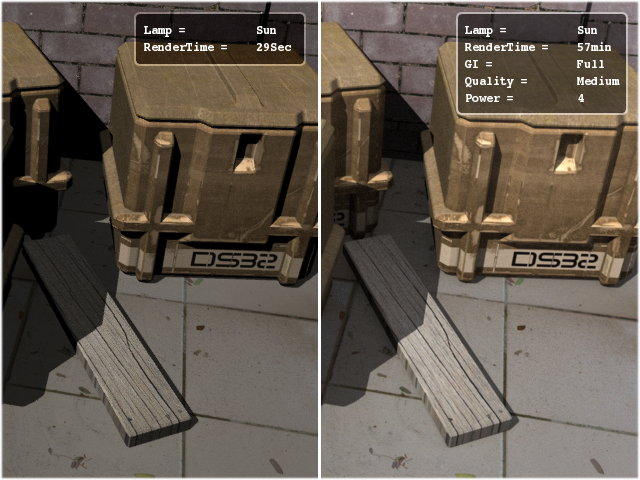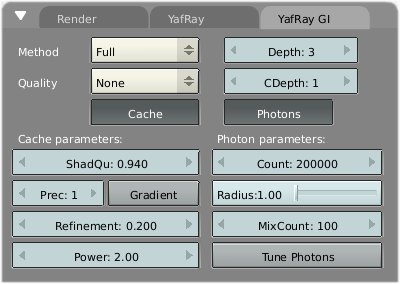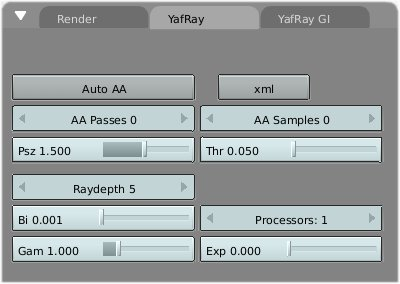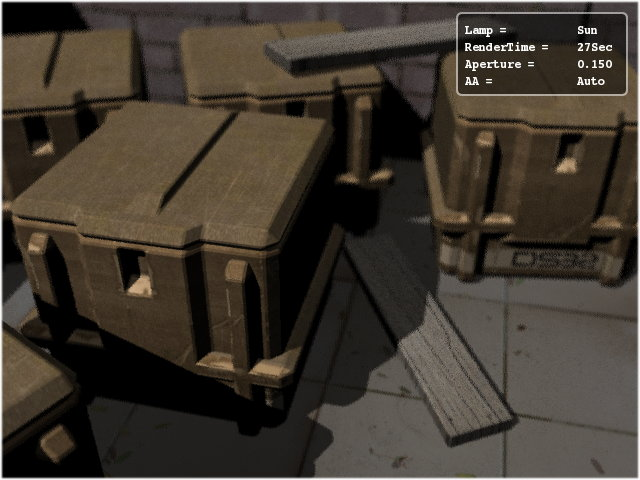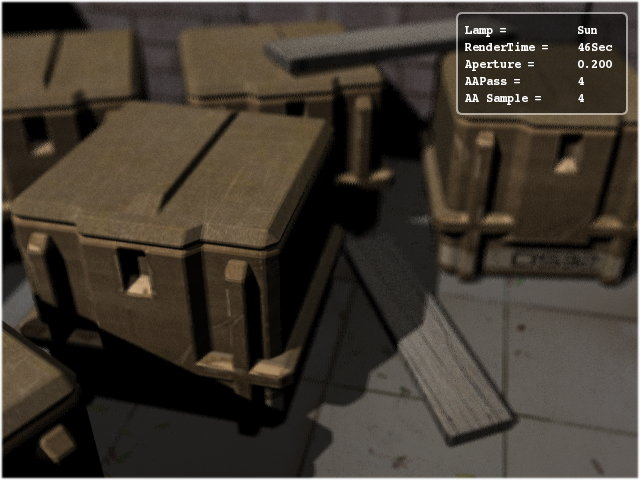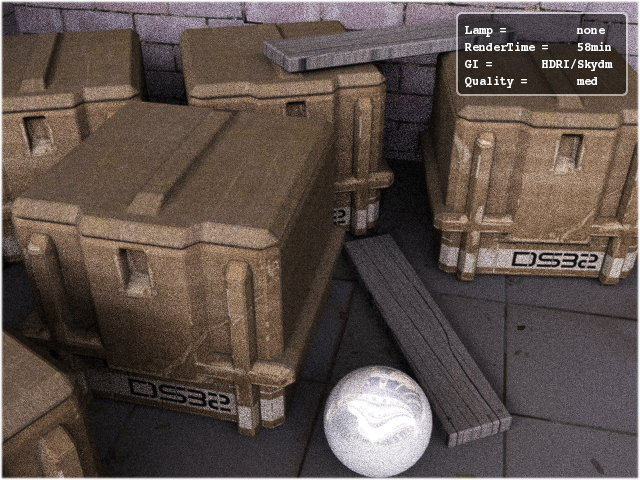Yafray supports Global Illumination*. We have
to go back to the Render tab to learn more about
Yafray's implementation of GI. The first look at the Yafray
GI tab and you might think 'Oh! It is so easy.' You are right,
the features available are simplified for your use. The available
options are Method and
Quality, let's have a look at them one by one. The
quality is the same for each and is explained later.
While Skydome is simply a method to have lighting from the sky or more appropriately the atmosphere, it does not provides full GI in the true sense, as it does not takes into account the indirect light bounces on the surfaces of objects. Rather it affects the light in the scene by the colour of the atmosphere and also the diffusion of light in the atmosphere is controlled by it. For example in the default scene the colour of atmosphere was set at reddish (chosen just to clearly identify the effect). See Figure 28.19, “The left part of image have the power of diffusion set at 2 while the right one at 4.” for how the diffusion affects the scene.
The colour of the background or atmosphere can be changed in
the Word Panel (F8). You have to
enable the world for Skydome to work fully. The Skydome offers no
other features. The Skydome is faster method of GI, while its
results may not be physically more accurate, its results are not too
bad to ignore for the speed advantage it offers.
On the other hand, the Full option takes into consideration the reflected and/or refracted light bounces (or indirect light) on neighboring surfaces. This method is a very close simulation of actual lighting in the real world, and that is why the GI produces more photo-realistic images than any other method used in CG, that is also why it requires higher computations and is slower.
Notice the difference in realism between the two parts in Figure 28.20, “Using Full GI increases the time as well as realism.”.The light bounces provide enough diffusion in the second part of the image, which lights up the shadow portion in the scene according to the distance of the surfaces in contact. While the first part has approximately similar shadow depth through out.
This refers to the total number of light bounces for one
reflected or diffuse ray. Generally Depth 3 works best for
normal scenes. Increasing the Depth results in higher amounts of
calculation per ray.
The Cdepth is nothing but the bounce depth
for caustics, or for the transparent materials like the glass, gems,
liquids etc. Higher computations are required for caustics
calculations, that is why the GI in CG keeps separate the normal
lights with photons, even though in the real world the photons are
the actual light particles. For better quality of caustics you will
need to have as much as 3-5 Cdepth or more for
detail.
This Photons button should not be confused with the photon
lamp. This is only used as a helper in global illumination for
Yafray and bears no relation with the caustic photon lamps or
caustic photons.
The Count refers to the total number of photons to be made
available in the scene for helper in GI. The number of photons
will vary for the scene, but higher numbers in the scene will
provide smoother results, again it's at your disposal to find the
time/quality limit.
This refers to the distance within which the photons calculated have higher precision value to effect the GI, outside which the photons do not effect the scene much. So the idea is to optimize the radius to the size of the area where better GI calculation is required; keep the radius half the size of area.
This allows you to choose the number of photons which should
be kept inside the Radius. The Radius and
MixCount make up your photon
map. The photon-map is nothing but the optimized area for
photons used in GI calculation and Yafray sufficiently processes the
sampling and photon gathering on the photons inside the photon-map
and leaves the photons outside the photon-map.
This allows the re-use of successful gathering of photons and positions from cache, which helped in GI calculation on previous render, and only re-compute the other photons for faster result. It is may not necessarily faster in every rendering but can provide good speed improvements generally. Due to speed improvement it is good to use it during test renders once you come close to what you wanted. You can disable it after you are satisfied with the test renders and want to create the final version of the image to do the full computation again.
The quality dropdown list allows you
to choose the quality level of GI for both the Skydome and Full GI
methods. The Quality setting allows control over the number of samples used
to test in GI. Since its use is automatic by default, it will try to
used maximum value for MultiPasses and
samples per pass depending upon the quality level. If
you want, you can disable the AutomaticAA manually
and can instruct Yafray accordingly.
The Yafray tab in Rendering
options window lists the options for manual control over
anti-aliasing. Press the AutoAA button to un-hide
the manual settings.
AA Passes: Selects the number of passes to be used for Anti-Aliasing. The higher the passes, the better the results, longer render times also. While using passes of more than one, every pass samples the total number of samples chosen in
AA Samplesfor every pass, thereby achieving better AA of pixels in noisier areas. If the results are noisier in a single pass you can increase the number of passes for better control and also a higher number of samples per pass. Single pass anti-aliasing with higher sampling, is not necessarily better than lesser samples with multipass.AA Samples: The number of samples per pass. The total AA sampling can be calculated by multiplying
AA PasseswithAA Samples. In our case for the the final blurred image for the DoF used below, we have used 4x4=16 anti-aliasing samples.Psz: The
Pszis the <Pixel filter size> that is used during the aliasing calculations. It indicates the number of neighbouring pixels used in the calculations.Threshold: This sets the threshold or the maximum brightness difference with the neighbouring pixel, when this is above the chosen level, extra samples are taken until the result is below the threshold limit or maximum samples/passes are reached. Lower threshold means more pixels will be antialiased, so at 0 all pixels in the render will be anti-aliased, when 1 no anti-aliasing is done.
Raydepth: This effects the maximum number of bounces a reflected/refracted ray can make. This is only important for glass and mirrors, higher ray depth will improve the quality of the reflection/refraction in the glasses and or mirror.
Yafray supports the real camera-like focus effect, Depth of Field. The DoF setting
can be accessed easily. First select camera in view port then press
F9. You will see a tab along with the Camera tab named
Yafray DoF. In the Camera tab enable Show
limits, doing this will allow you to see a yellow cross on the
Show limits line of the camera in Viewport. The
yellow cross is what we need to put at or near the objects we want to
have sharp focus on. That distance can be set by the
DoFDist numeric button. The Aperture setting is the
value you need to change to get the required DoF you want. Normally a
setting in-between .100 to .500 will suffice for most scenes.
How to remove the artifacts in DoF rendered scenes. DoF filter
requires more samplings per scene to get the right amount of blurring.
To do that you need to disable Automatic AA in
Yafray tab in Render panel. Here try to adjust the
AA Passes and AA Sample
accordingly. If you have large aperture settings then you need to have
multiple passes plus higher samplings per pass. Increasing anti-aliasing
will also increase the render times.
Yafray has HDRI support. To use this go to World buttons
F8. Go to Texture and Input tab and
add a new texture. Then go to texture selection F6
select Texture type as image, press Load
image button, locate the HDR file, select and press
Enter. Blender will not show the HDRI image in the
World tab, however it is loaded automatically during
rendering. You can also increase or reduce the exposure of the HDRI from
the Texture brighteners button in the
colour tab in texture window
(F6). The possible exposure settings are -1,0,1, for
brightness' sliders at 0,1,2. This is because HDRI exposure can be
modified in integer values only. For the final step, use any one of the
GI methods. Generally Skydome will work fine.
I would like to thank eeshlo, to an large extent I was motivated to learn about Yafray because of him, and thus was able to write this tutorial, and also for his help in solving my queries. Thanks also goes to Dreamsgate for helping in the editing and support for this document.
This tutorial is not finished, as there are several aspects which I have not tried myself, like caustics, and GI techniques for certain types of renderings. So I call this tutorial version 1. Later improvements will not necessarily come at regular intervals. If you have any queries or have some point that I overlooked or misunderstood in the matter written above, I would be glad to hear from you. Also welcome are the suggestions for improvements. My mail-id

